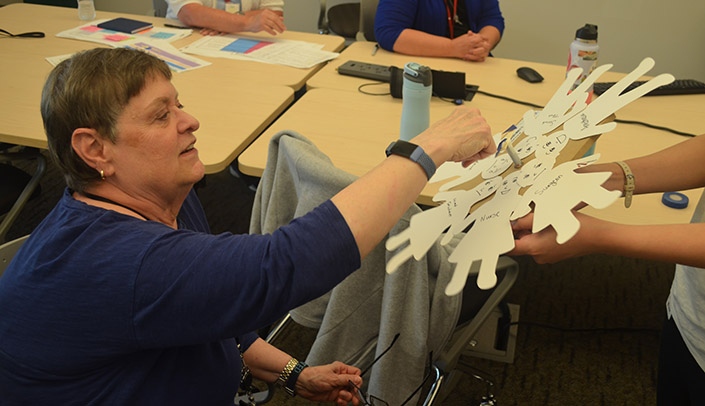This summer, the UNMC College of Medicine held a design thinking workshop for its students.
The theme was interprofessional care. Teams of students met with university faculty and leaders who recounted memorable experiences they had had in team-based care and the students were challenged to improve interprofessional healthcare with a design-thinking strategy.
The students worked in teams to come up with innovative solutions to real-world interprofessional problems, sharing their ideas at an assembly at the end of the event.
"There were two different cohorts, one in June and one in July," said Jennifer Kallio, DDS, of the UNMC College of Dentistry, who worked with College of Medicine leaders to hold the event. "There was representation from all the colleges from both the faculty empathy interviews and the coaches who worked side by side with the students."
Design thinking concepts help with team dynamics, leadership and empathy, said Dr. Kallio, who said the college’s events were the first UNMC has held for students. It puts the students in an ambiguous problem space without a clear answer and challenges them to come up with ideas using a human centered lens.
"That’s a potential opportunity we really haven’t explored yet," she said.
Medical student Conner Beyersdorf was at first hesitant about the concept.
"I have a background in engineering and engineering design, so the problem-solving process looks different there," he said. "But it was a worthwhile experience, and there really isn’t any situation in health care now where you’re not working in interprofessional teams."
Student Christina Zhou said she enjoyed the activity and going through this brainstorming process.
"I felt the hands-on building/crafts aspect was the most interesting part, since that's something we don't really do in med school," she said.
Kate Fiandt, PhD, of the UNMC College of Nursing, served as the faculty member who worked with Beyersdorf’s group. It was her first experience in design thinking, as well. She said she was impressed by some of the solutions she saw at the assembly, but she would have liked to have seen students from other disciplines participate with the med students, as well.
Geoffrey Talmon, MD, one of the faculty members who reviewed the medical students’ final presentations, agreed that the event could be a springboard to more student-focused design thinking workshops.
"To me, that’s the next logical step," he said.
He was impressed by the students’ results.
"These design thinking events usually are a multi-day or weeklong process," Dr. Talmon said. "These students were able to do a whole lot in a big hurry, and some of the things they came up with definitely could be impactful.
"Future events could be cross-college and would enrich all those who participate in them," he said. "Just based on what I saw students come up with during this event, we’ve got a model for future activities."
Bradley Britigan, MD, dean of the UNMC College of Medicine, said he was impressed with the quality of the work accomplished by the students in a very short period of time.
"The presentations I heard reflected a high level of creativity and desire to improve the care and experience of patients through interprofessional collaboration," he said.
